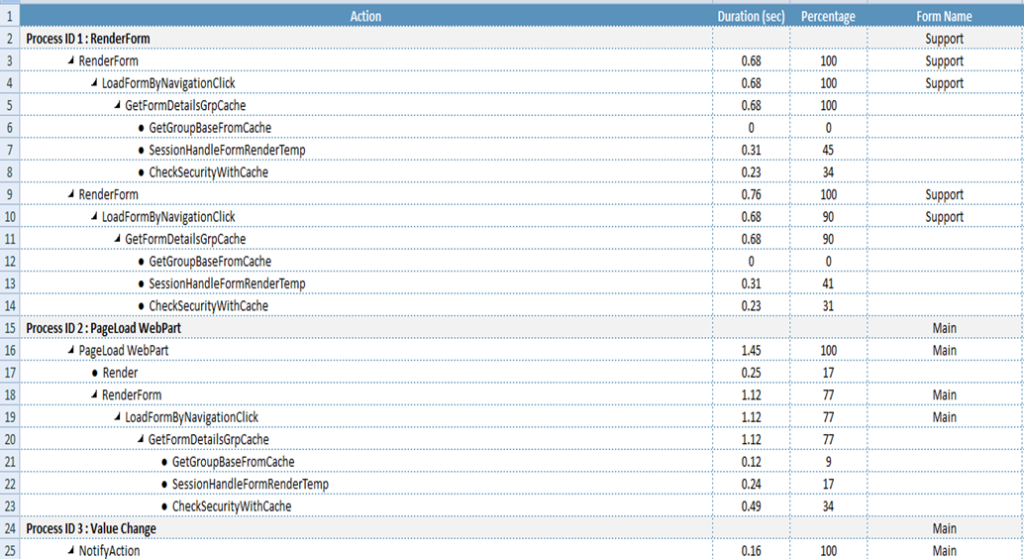Application Monitor
Application Monitor is used to monitor the complete workflow of the forms we create in AppForms. All the iterations ongoing in the form will be monitored in each instance of time frame and will be displayed. For enabling Application Monitor the user must set up the following things below.
Turning ON Application Monitor
Click on the links tab, Select Application Monitor under Site Admin menu.

The Application Monitor window will be opened up in the right window pane.

Turn on the Application Monitor. There are two options for enable logging to monitor the performance of the form. Select either JSON (default) or SQL. JSON is more preferable than SQL as it is the fastest mode of logging data. Select SQL when there is a need for diagnosing exceptions as it Logs every action even the incomplete ones.
For saving the changes the user must click on Update button. A dialog box will be shown confirming the changes.

Now go to any form where you have written some actions to perform a task. As an example here we are going to monitor a form using Application Monitor.


In this example there are almost four rules that perform different actions. Preview the form; perform any action in the form and go back to the Application Monitor menu. Now we can see that there is a link available in the menu ‘View Application Report’.

Click on this link, this will take to the details page which give the user details regarding the Session ID, Current User, Date, Start Time, Complete work flow monitoring details. There is another option to delete a particular details section.

Clicking on the ‘view details’ link under Details label will give you the complete history after monitoring the process carried out in the form. This is shown in the above figure. You can see that each action in the rule is monitored and detailed in Time and Percentage scales. A user can even import these details into an Excel sheet for further analysis. For this click on the excel icon on the bottom right corner of the window and save the excel file generated.


Rule Execution Monitor
Rule Execution Monitor in AppForms serves as a powerful tool to oversee the entire workflow of forms created within the platform. It provides real-time monitoring of ongoing iterations, offering valuable insights into form performance. To leverage the benefits of Rule Execution Monitor, users need to follow specific setup steps outlined below.
Setting Up Rule Execution
Monitor Accessing the Rule Execution Monitor in the designer interface is a straightforward process. Within the designer, navigate to the left link section and click on ‘Application Monitor.’ This action will direct you to the screen where the Rule Execution Monitor can be enabled. Toggle the ON button, and remember to click ‘Update’ to save the settings.

If you need to enable the setting for a specific user or user group, the ‘User specific rules log’ option can be activated. To add users or groups, use the search text box on the screen. Selected users can be cleared using the ‘Clear All’ button, or individual names can be deleted using the ‘Delete’ button available in the row line.

Clicking on the link “View Rule Execution Report” will redirect you to a different page where the entire flow is monitored. Each iteration is presented in the grid, and clicking on the ‘View Details’ link will provide a detailed overview of the iteration. It includes information on the time taken for each action, facilitating performance analysis of the form. The ‘Delete’ link can be used to delete a specific iteration, while the ‘Delete All’ link removes all iterations.

Clicking on the excel image button will download the report for detailed review and analysis.
Note: Properly configuring and utilizing the Rule Execution Monitor enhances form analysis and ensures effective monitoring of rule executions within the ClaySys AppForms environment.
Conclusion
In conclusion, Rule Execution Monitor in AppForms empowers users to actively monitor and analyse the workflow of created forms. By following the outlined setup steps, users can efficiently utilize the features of the Monitor, gaining valuable insights and facilitating detailed analysis of form performance. This tool enhances the overall user experience by providing transparency and detailed records of form interactions